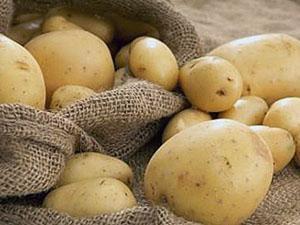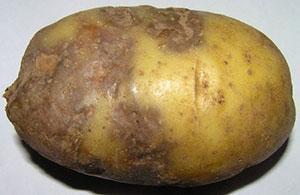Photos and description of potato diseases
 Potatoes are perhaps the most popular vegetable, which is cultivated by more than 80% of summer residents. It is he who is more often than other cultures affected by various infections. Bacterial, fungal or viral diseases of the potato can destroy most of the crop even before it is harvested. Even when storing healthy looking potatoes, there is a risk of spoilage. In this case, the infection from the tubers can spread to other vegetables stored with the potatoes.
Potatoes are perhaps the most popular vegetable, which is cultivated by more than 80% of summer residents. It is he who is more often than other cultures affected by various infections. Bacterial, fungal or viral diseases of the potato can destroy most of the crop even before it is harvested. Even when storing healthy looking potatoes, there is a risk of spoilage. In this case, the infection from the tubers can spread to other vegetables stored with the potatoes.
To protect yourself from the loss of harvested and stored crops, it is important to detect signs of infections in time. The most common ones belong to three groups:
- fungal infections - late blight, alternaria, scab, cancer, phomosis and fusarium;
- viruses - mosaic and necrosis;
- bacterial diseases - brown and ring rot, black leg.
Each group is represented by several harmful infections that can reduce the potato yield by 3-5 times. According to statistics, the greatest crop losses are caused by fungal diseases of the potato.
Late blight

When diseased plants appear, it is important to practice potato crop rotation, because phytophthora spores persist in the soil, on the remains of the tops and in tubers.
It is not recommended to store tubers infected with late blight, since in this case there is a risk of losing the entire crop, including vegetables that are in the same room with diseased potatoes.
Potato cancer
 Another dangerous infection is potato cancer. In areas where cases of potato infection are recorded, a quarantine regime is introduced. This fungal disease affects the tubers and stolons of the plant, leaf blades and stems. Growths appear on the tubers in the immediate vicinity of the eyes, which increase in size. Despite the absence of obvious rot, tubers diseased with cancer should not be stored.
Another dangerous infection is potato cancer. In areas where cases of potato infection are recorded, a quarantine regime is introduced. This fungal disease affects the tubers and stolons of the plant, leaf blades and stems. Growths appear on the tubers in the immediate vicinity of the eyes, which increase in size. Despite the absence of obvious rot, tubers diseased with cancer should not be stored.
To avoid the appearance of the disease, it is important to choose varieties resistant to it. When potato cancer appears, it is necessary to destroy the infected tubers. The field on which the foci of the disease are found should not be sown with potatoes for at least 3 years.
Alternaria potato
 This disease can destroy the entire plant, including stems and tubers. Most often, medium-late and late varieties become its victims. The first signs of infection can be recognized by the appearance of brown spots on the leaves, which appear before the flowering of the plant. Over time, diseased leaves turn yellow and die. Pockets of infection on tubers are also easily recognized by their brown color and irregular shape. If Potato Alternaria affects most of the tuber, the surface of these spots may appear wrinkled.
This disease can destroy the entire plant, including stems and tubers. Most often, medium-late and late varieties become its victims. The first signs of infection can be recognized by the appearance of brown spots on the leaves, which appear before the flowering of the plant. Over time, diseased leaves turn yellow and die. Pockets of infection on tubers are also easily recognized by their brown color and irregular shape. If Potato Alternaria affects most of the tuber, the surface of these spots may appear wrinkled.
Similar to this disease, potato phomosis manifests itself, with the only difference that the spots on the tubers acquire a grayish tint, and their size does not exceed 2-5 cm in diameter. Another significant difference is the timing of infection.If Alternaria penetrates into the young stems of the plant, then the phomosis affects the stems in the second half of the growing season. The spores that have ripened on them, along with rainwater, enter the soil, where the tubers are infected.
Before storing planting material from a site where plants infected with phomosis and alternariosis have been seen, it is important to pickle the tubers. The infection can be contained by observing the temperature regime in the basement.
Scab
 Large crop losses can be incurred when they are affected by various types of scab: ordinary, powdery or silvery. Common scab develops only at high soil temperatures and low humidity. Diseased tubers are covered with dry, slightly protruding dark spots above the surface of the skin. This type of scab does not affect stems.
Large crop losses can be incurred when they are affected by various types of scab: ordinary, powdery or silvery. Common scab develops only at high soil temperatures and low humidity. Diseased tubers are covered with dry, slightly protruding dark spots above the surface of the skin. This type of scab does not affect stems.
Powdered potato scab acts in the same way on plants. It affects only the underground part of plants. At the initial stage, rounded spots with a diameter of 6-7 cm, covered with a white bloom, appear on them. Over time, these areas are destroyed, and in their place, red sores remain. Unlike ordinary scab, powdery scab is active only at high humidity.
The silvery scab affects only tubers during storage. As a result of infection, they lose a large amount of moisture, which makes them light and excessively dry. Such potatoes are not suitable for planting. An outbreak of the disease is provoked by high humidity (more than 90%) and a temperature above 3 degrees.
To avoid mass infection of tubers with any kind of scab, it is important to observe the potato crop rotation. It is important to pay attention to the preparation of planting material: dressing before storage will prevent re-infection of tubers and soil.
Black leg of potato
 The disease develops as a result of damage to the plant by the bacteria Pectobakterium. The source of infection is diseased potato tubers, plant residues in the soil. Often spread by insect larvae. It affects almost all parts of the plant at any stage of development. It becomes chronic in dry conditions. Potato bushes begin to hurt immediately after germination. First, the leaves turn yellow, then they curl up and dry out. The bush fades quickly, the stem becomes soft and easily pulled out of the ground. On the tubers, the black leg of the potato appears as dark rot in the part of the stolon.
The disease develops as a result of damage to the plant by the bacteria Pectobakterium. The source of infection is diseased potato tubers, plant residues in the soil. Often spread by insect larvae. It affects almost all parts of the plant at any stage of development. It becomes chronic in dry conditions. Potato bushes begin to hurt immediately after germination. First, the leaves turn yellow, then they curl up and dry out. The bush fades quickly, the stem becomes soft and easily pulled out of the ground. On the tubers, the black leg of the potato appears as dark rot in the part of the stolon.
Fusarium wilting
 Another potato disease, in which yield losses can reach 50%, is fusarium wilting. Most often, it develops in conditions of high temperatures and humidity. At first, Fusarium can be mistaken for diseases of the potato tops, photos of which are often flashed in specialized publications. The infection affects the leaves of the plant: the upper ones become light, and the edges of the lower ones acquire an anthocyanin hue. Over time, they lose their elasticity and wither. On the lower part of the stems, spots appear, covered with a bloom of orange or pink. Once in the soil, the infection also affects the tubers, causing them to rot.
Another potato disease, in which yield losses can reach 50%, is fusarium wilting. Most often, it develops in conditions of high temperatures and humidity. At first, Fusarium can be mistaken for diseases of the potato tops, photos of which are often flashed in specialized publications. The infection affects the leaves of the plant: the upper ones become light, and the edges of the lower ones acquire an anthocyanin hue. Over time, they lose their elasticity and wither. On the lower part of the stems, spots appear, covered with a bloom of orange or pink. Once in the soil, the infection also affects the tubers, causing them to rot.
To avoid the death of the crop from fusarium, it is enough to mow the infected tops and remove all plant residues from the site. Only then can you start harvesting potatoes.
How to treat potatoes from fungal infections?
 It is necessary to fight against fungal diseases of potatoes even at the stage of preparing the planting material. Before treating potatoes with a solution of boric acid or copper sulfate, it is important to select tubers that are not damaged by infections. During the growing season, it is necessary to constantly monitor the condition of the tops. At the first signs of disease, it is necessary to remove the affected plants, and then process the plantings with a 2% solution of copper sulfate, Hom or Maxim.
It is necessary to fight against fungal diseases of potatoes even at the stage of preparing the planting material. Before treating potatoes with a solution of boric acid or copper sulfate, it is important to select tubers that are not damaged by infections. During the growing season, it is necessary to constantly monitor the condition of the tops. At the first signs of disease, it is necessary to remove the affected plants, and then process the plantings with a 2% solution of copper sulfate, Hom or Maxim.
Fungal infections often enter the soil with incompletely rotted plant debris and manure.It is important to exclude such phenomena, as this will reduce the labor costs of treating crops with special means and increase the amount of the crop. To avoid contamination of tubers during harvesting, it is necessary to mow the tops in advance and remove plant residues from the site. Tubers damaged during transportation and storage should be eaten in the first place, since they are most often affected by infections.
Of no small importance is also crop rotation potatoes. Most fungal diseases exist in the soil for 2-3 years. In the absence of cultures on this territory capable of becoming carriers of infection, it spontaneously disappears.
This 2015 all potatoes were sick. There was no harvest. Such signs were not only on our site, but also on the neighboring ones. All potatoes died. The disease developed gradually. Doubt what kind of disease it is?
And more photos
The disease began with yellowing of the leaves, as in chlorosis. In the photo, a general view of the planting of potatoes is approximately the middle from the time of yellowing of the leaves to the death of the plants.
There were probably very often fogs in your region. Potatoes are affected by late blight, Fusarium or Alternaria. It is better to prevent such a bouquet of diseases than to cure. At this stage, you can still use the drug Fitosporin-M. In the early stages of development, use preparations containing copper for preventive treatment. To protect the potato planting next year, you need to follow the rules of crop rotation. Potatoes are not planted after nightshade crops. Pick up another planting material that is resistant to late blight.